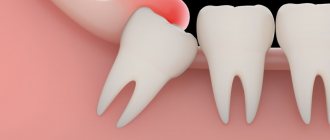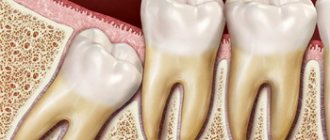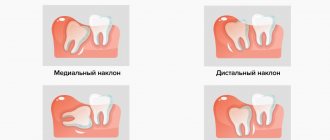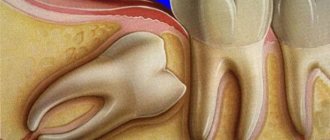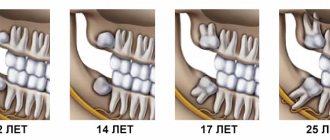From this article you will learn:
- symptoms of wisdom tooth growth,
- what to do if your wisdom tooth is cutting out and your gums are swollen or you have a fever.
The article was written by a dental surgeon with more than 19 years of experience.
The wisdom tooth is located at the very end of the dentition, and therefore it is often called the “figure eight” (the serial numbers of the teeth are assigned starting from the central incisors). Thus, a person has only 4 wisdom teeth - one on each side of the upper and lower jaw. No other teeth cause us so much discomfort and pain when they begin to erupt. It most often occurs between the ages of 18 and 21, but can occur at 14 or 40 years of age.
It is interesting that the incidence of difficult wisdom teeth eruption increases with each generation. This is due to the chewing load, and the fact that people are increasingly eating too soft, overly processed food. As a result, the chewing load that the teeth transmit to the bone tissue of the jaws turns out to be insufficient, which leads to a gradual decrease in the mass and volume of the bone, including a decrease in the length of the lower jaw. As a result, with the same number of teeth, we have less and less space for their eruption.
How a wisdom tooth is cut: photo, x-ray
As a result, competition arises between teeth for a place in the dentition, and those teeth that erupt last are in the most disadvantageous position. Most people are familiar with the fact that when a wisdom tooth is cut, the symptoms of eruption and associated inflammation can cause a lot of inconvenience. And this is not only pain, suppuration or just felt discomfort. If there is not enough space in the dentition, the erupting wisdom teeth put pressure on the teeth in front, moving them to the center of the dentition. It is for this reason that many patients experience crowding of their front teeth over time.
A few facts about wisdom teeth –
Wisdom teeth are the only teeth in which the formation of germs does not occur during intrauterine development, but already in a born child at the age of 4-5 years.
In this case, the crown part of the wisdom tooth completes its formation at the age of 12 years, and the end of the formation of the roots usually occurs no earlier than 24 years. On the x-ray you can see a wisdom tooth whose roots have not yet completed formation (compare with the roots of the 7th tooth in front). Well, the last feature that we talked about above is that the eruption of all other teeth in the permanent dentition occurs in the period from 6 to 13 years, and only the eighth teeth usually begin to erupt no earlier than 18-21 years.
Signs of growth of the eight
The emergence of a wisdom tooth to the surface is usually accompanied by pain. The discomfort is due to the fact that the bone tissue damages the gums. In addition, in place of wisdom teeth, precursors are not formed, which facilitate the process of the appearance of permanent elements. The pain when figure eights appear can be compared to the discomfort that small children experience during the process of teething. In addition to pain, other signs of the condition are also noted - itching, swelling of the soft tissues of the gums. Not in all cases, the teething process is accompanied by discomfort. Sometimes people discover a new tooth in their row completely by accident.
Other symptoms of the condition:
- swollen gums located away from the problem element;
- radiating pain to the head, ear or cheek;
- difficulty swallowing;
- the appearance of bad breath.
The last sign appears due to the fact that during the process of eruption a hood is formed above the figure eight. It is a compaction of overgrown mucous membranes. Plaque, bacteria, and food particles accumulate under the hood, eventually leading to bad breath.
In severe cases, a person develops symptoms of malaise and intoxication. Also, severe eruption of the element is accompanied by fever, inflammation of the submandibular lymph nodes, and severe headaches. Signs of the condition are individual for each person. There may be only one or many signs of a problem. The duration and intensity of the symptoms of figure eight eruption are also individual in each specific case.
Wisdom tooth hood
Complications associated with teething
With pathological germination of the figure eight, a number of complications can develop. A common disorder is pericoronitis. The disease is associated with inflammation of the tissues of the jaw and mucous membranes of the mouth.
Characteristic signs of pericoronitis:
- the appearance of severe swelling and redness in the eruption area;
- sore throat when swallowing;
- deterioration of health;
- weakness;
- temperature increase;
- discharge of purulent masses when pressing on the gums.
Often pericoronitis becomes chronic, which is accompanied by pain and discomfort when pressing on the problem area. An abscess may form in place of the tooth.
Carious lesion is another consequence of improper eruption of figure eights. The fact is that the last molars may fit too tightly to the sevens, which makes it difficult to naturally clean the dental space from plaque and bacteria. As a result, caries develops with all its characteristic symptoms:
- darkening of the enamel;
- pain when chewing;
- tooth sensitivity.
Sometimes it happens that the figure eight comes out on the surface of the already affected gum.
Periodontitis appears after the eruption of the last molar. The pathology is characterized by inflammation of the gums due to the inconvenient location of the wisdom tooth in the gum. In this case, plaque and bacteria from the oral cavity are almost impossible to remove using standard hygiene measures. Bacteria in the space between the gum and tooth provoke inflammation and swelling of the soft tissues of the mouth. If a visit to the dentist is untimely, periodontitis is complicated by gumboil or periostitis.
What to do if a wisdom tooth comes out and your gums hurt
Symptoms of flux manifest clearly and are accompanied by:
- temperature rise to 40 degrees;
- swollen cheeks;
- swelling spreading to most of the face;
- intoxication of the body;
- excruciating pain.
As a result of abnormal eruption of the figure eight, a cyst can grow - a benign tumor filled with clear liquid. It contains particles of dead cells, bacteria and food debris. You can notice a cyst by protruding gums and discomfort when chewing food. Rarely, a cyst is accompanied by severe pain.
The appearance of a wisdom tooth above or below can cause damage to the trigeminal nerve. If it is violated, there is involuntary twitching of the face and severe sharp pain. In severe cases, facial paralysis may occur.
Abscess is one of the most severe complications associated with the pathological eruption of the last elements. It develops in the most patient patients. Among the signs of the disease are:
- sharp putrid odor from the mouth;
- constant feeling of bitterness;
- heat;
- throbbing pain.
When the abscess goes inside, phlegmon or an extensive inflammatory process develops. Swelling spreads to the entire face.
Cellulitis is a complication that can cause the patient’s death
You need to be attentive to all the symptoms that manifest the eruption of wisdom teeth. If pain persists for more than 2-3 days, then you need to seek help from a dentist. It is recommended to independently relieve the symptoms of the condition only if it is not possible to visit a specialist. For this purpose, it is permissible to use painkillers and traditional medicine. During a visit to the doctor, it is necessary to tell you that pain relief measures were taken regarding the problem unit.
How to prevent pain
To reduce the risk of inflammatory processes in the socket and the development of pain, the doctor gives the patient recommendations on how to behave immediately after extraction:
- hold a sterile swab between the teeth, which is placed to stop gum bleeding for at least 20 minutes;
- refrain from eating for 2–3 hours after removal;
- take a painkiller tablet in the first 1–2 hours after the wisdom tooth root has been removed, Ketorol, Ketanov, Baralgin are suitable;
- avoid smoking, alcoholic beverages, spicy foods, hot and cold drinks, physical activity on the first day;
- rinse with antiseptic solutions Furacilin, Chlorhexidine, chamomile decoction, starting from the second day after extraction (this cannot be done earlier, so that a blood clot will form in the hole, it will protect the wound from infection);
- apply antiseptic ointments and gels to the affected area - Metrogyl Denta, Asepta, Cholisal, Solcoseryl.
Antibacterial drugs are usually prescribed in cases where a tooth has been pulled out, surrounded by suppuration or with flux located nearby. Then the patient is required to take the drugs for at least 5–7 days in a row, in order to avoid recurrent complications
As you can see, modern dentistry has stepped far forward, giving patients the opportunity to remove problem teeth painlessly and with the least risk of complications. The drugs used today for anesthesia do not cause side effects or allergies, have a quick and long-lasting effect, allowing you to reduce discomfort to a minimum. After extraction, you do not need to go to the dentist to remove the sutures again - doctors use self-absorbing threads, as they save the tissue from additional trauma.
An important point is the psychological mood of the patient himself. Having read and heard stories about terrible pain during tooth extraction, a person delays a visit to the doctor, provoking complications that can be avoided by seeking help in a timely manner. Therefore, you should not be afraid of the dental chair - the doctor will do everything possible to ensure that the patient does not experience discomfort, and the fear of dentists is a thing of the past.
When do wisdom teeth grow?
At what age do eights begin to grow? Each person has an individual time frame for the eruption of the last units. For some, eights appear on the surface of the gums as early as sixteen. However, such situations are rare. On average, this period occurs between the ages of 17–25 years.
The number eight can grow and form over a long period of time. For example, the tip of the tooth appears at the age of 20, and the final tooth is formed only at the age of 30–35. In some patients, the figure eights remain retracted, that is, they do not appear on the surface of the gums.
At what age do the last molars stop growing? These elements creep in throughout a person’s life. There have been cases where molars grew in older people.
Cutting through the figure eight is a long and complex process that takes from several months to several years. During this process, characteristic symptoms may worsen and subside.
At what age do third molars appear?
There are no “eights” in the milk bite. Moreover, their rudiments are not laid during the intrauterine development of the fetus; this process begins only closer to 4-5 years. Crowns are finally formed by 11-12 years, and roots only by 24-26 years. It is believed that around this period they begin to break out. But in practice, situations are common when they appear much later, for example, after 30 years. Or they don’t make their way out at all until the end of life, or they appear only partially (not in full).
How long do eights grow?
The period for the last element to appear on the surface ranges from 4 weeks to 10 years. On average, patients may experience discomfort from the eruption of wisdom teeth for up to 1.5 months. After the crown appears, the discomfort subsides. Then there is a pre-formation stage, which can take up to 5–7 years. An element is considered formed after its roots appear, which can number from 3 to 5.
Only a doctor can decide whether to remove the problematic element or not. The main indications for surgical intervention are chronic pericoronitis, compression of the roots of an adjacent tooth by the figure eight, damage to the soft tissue of the gums on the crown of a molar. If there are no problems when cutting through the unit, then experts leave the eights untouched. These teeth are as important as all other elements, despite the fact that they do not take part in the digestion of food.
Squeezing an adjacent element with a figure eight
The last molars prevent the remaining teeth from moving to the side and prevent various malocclusions. When prosthetizing sevens, the last molars can be considered as a support for orthodontic structures. For this reason, doctors try to preserve the element even if it is damaged by caries.
What determines the symptoms of teething?
At what age does a figure eight form? Typically, the coronal part of the element is formed by the age of 14, when the dentofacial system is fully formed. Teeth are cut much later – between the ages of 18 and 30.
The faster the tooth appears on the surface, the lower the risk of complications. The rate of tooth growth depends on the availability of free space in the oral cavity and the density of the gum tissue. Such conditions are rare, and patients usually have to contact their dentists when the last elements appear on the surface. With prolonged growth, a hood is formed near the gums, under which food debris gradually gets stuffed. This environment is optimal for the development of pathogenic flora.
The dentist helps get rid of the unpleasant symptoms of teething by opening the hood and washing it with antiseptic solutions. Sometimes the surgeon makes an incision in the gum to facilitate the process of tooth emergence. If there are clinical indications, the molar is removed without waiting for it to come out.
General recommendations for teething
What to do when third molars appear? At the first symptoms of a problem, you should consult a doctor. If this is not possible in the next few days, then at home you can also make it easier for the tooth to come out. First of all, you need to clean your mouth with a paste and brush to deactivate the pathogenic flora. After hygiene measures, the mouth is rinsed with antiseptic solutions or herbal decoctions that have an anti-inflammatory effect (calendula, chamomile, oak bark). You can use just one herbal ingredient or several herbs to relieve pain.
It is forbidden to pierce the gums with sharp objects on your own. Such actions can lead to even greater swelling of the soft tissues and the spread of infection throughout the body. It is also not recommended to constantly touch the problem area with your hands and tongue. During the visit, the dentist will ask the patient to undergo an X-ray examination to determine the integrity of the wisdom tooth and the location of its roots. If an element is affected by caries or its roots are pressing on adjacent teeth or more elements, then extraction is suggested. After tooth extraction, patients must adhere to all the specialist’s recommendations so as not to provoke complications.
Reviews
Olesya: I was terribly afraid to go remove the wisdom tooth from below - I rinsed my mouth with chamomile, took painkillers, but the pain did not go away. After 5 days of torment, I finally decided to go to the appointment, the doctor scolded me that I provoked inflammation of the gums. After the removal, my entire jaw hurt, I again took painkillers, and also antibiotics, since I myself started the infectious process. After 2-3 days everything returned to normal, the pain went away, but I still regret that I didn’t go to the doctor on time - pulling out a tooth with an injection was not scary at all, I didn’t feel anything.
Oleg: Two years ago I had my upper wisdom tooth removed, then everything went smoothly, the whole process took literally 5 minutes. After the anesthesia wore off, my teeth hurt, but not too much - I took only one tablet of Ketorol. Recently I had to remove a figure eight from below - the process took much longer (as the doctor explained, the tooth had thick, curved roots). During the removal, I didn’t feel anything, it didn’t hurt, but then I couldn’t sleep for two nights - my gums were severely injured. Now everything is fine, it has healed, there were no complications.
Irina: My first wisdom tooth at the bottom grew straight and didn’t cause any problems, but a year later it was struck by caries. The hollow grew very quickly, and soon severe pain began. I went to the doctor, he said that the caries was already very deep, and there was no point in treating the tooth - the eights very quickly collapse and rot, and he suggested removing it. I was very afraid, but the doctor sent me for an x-ray, the roots turned out to be smooth and thin, so it didn’t hurt when removed. My jaw ached for about two days, but then the discomfort went away, so I shouldn’t have worried that something would go wrong.

